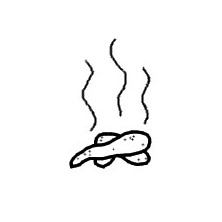Dehydration by adding dry organic material and long-term storage at high ambient temperature is the simplest treatment in order to transform faeces into a product that is safe for reuse or disposal. Dehydration can take place either on-site in a dehydration vaults or be done off-site in dehydration beds or bags protected from humidity. Dehydration vaults are used to collect, store and dry (dehydrate) faeces on-site (e.g. in double-vault UDDTs) . Faeces will only dehydrate when the vaults are well ventilated, watertight to prevent external moisture from entering, and when urine and anal cleansing water are diverted away from the vaults. Simple storage at ambient conditions (temperature, pH and moisture) can require several years for pathogens to die-off. Increase of temperature, pH (alkaline treatment) and minimisation of the moisture content can significantly accelerate the process. Clever design and ventilation will increase temperature and decrease moisture content, thereby enhancing the drying process. The addition of lime and ash will raise pH while sawdust will absorb humidity.
| Entradas | Salidas |
|---|---|
Faeces, Dry Cleansing Materials |
Dried Faeces, Compost/Biosolids |
Direct use of excreta, human faeces and urine results in the beneficial use of plant nutrients to agricultural land (SCHOENNING & STENSTROEM 2004). These products usually do not contain industrial chemical contaminants that may hamper the reuse of municipal wastewater, but should be treated to reduce the levels of human pathogens to a safe level (SCHOENNING & STENSTROEM 2004).
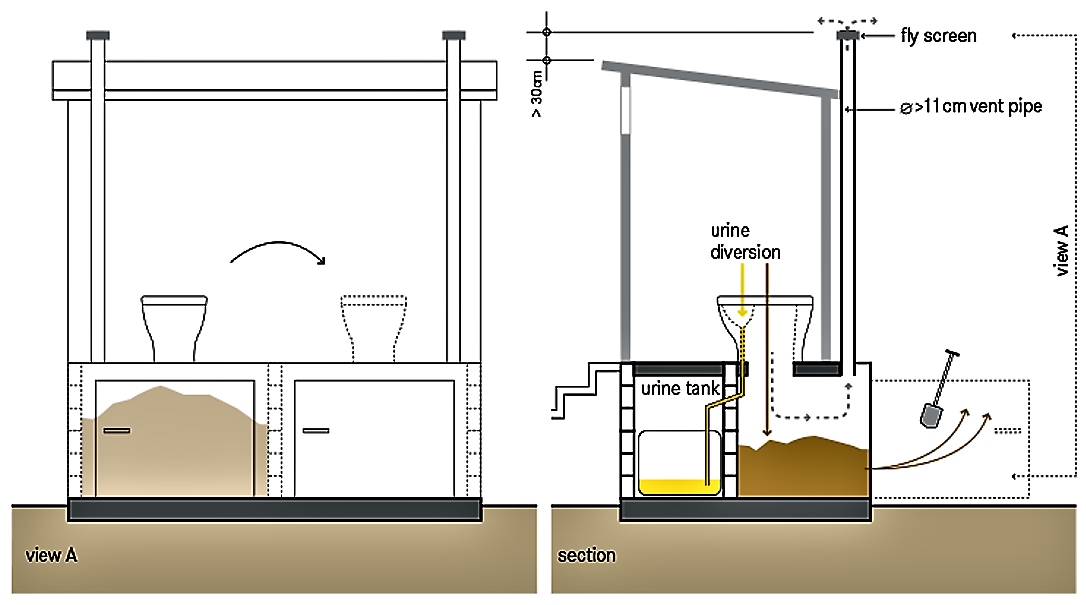
The treatment of faeces from dehydration sanitation systems (such as urine diversion dehydration toilets, or UDDTs) generally requires a primary and a secondary treatment in order to transform them into compost, even if the distinction between these treatments is often diffuse (JOENSSON et al. 2004).
The primary treatment takes place during the collection of the faeces in the dehydration vaults. It aims to reduce the volume and the hygiene risk (i.e. to reduce the number of potential pathogens in the faeces), and to decrease the risk of odours and flies (JOENSSON et al. 2004).
When faeces are not mixed with urine and other liquids, they dry quickly. In the absence of moisture, organisms cannot grow, pathogens are destroyed and smells minimized.
The use of two alternating vaults in allows the faeces to dehydrate in one vault while the other vault fills. When one vault is full, the seat of the Urine-Diverting Dry Toilet (UDDT) is moved to the second vault. While the second vault fills up, the faeces in the first vault dry and decrease in volume. When the second vault is full after approximately 6 month , the first one is emptied and put back into service.
To prevent flies, minimize odours and encourage drying, a small amount of ash, lime, dry soil or sawdust should be used to cover faeces after each use.
The factors influencing the primary treatment are time, temperature, dehydration and pH.
The secondary treatment can take place in the toilet itself (e.g. in a double-vault urine diversion dehydration toilets)) or off-site on drying beds or in air-permeable bags protected from the rain (JOENSSON et al. 2004). The main objective of the secondary treatment is to render the faeces hygienically safe and transform them into humanure, which is odourless and visually non-repulsive (it should no longer be possible to recognise pieces of faeces or toilet paper, JOENSSON et al. 2004).
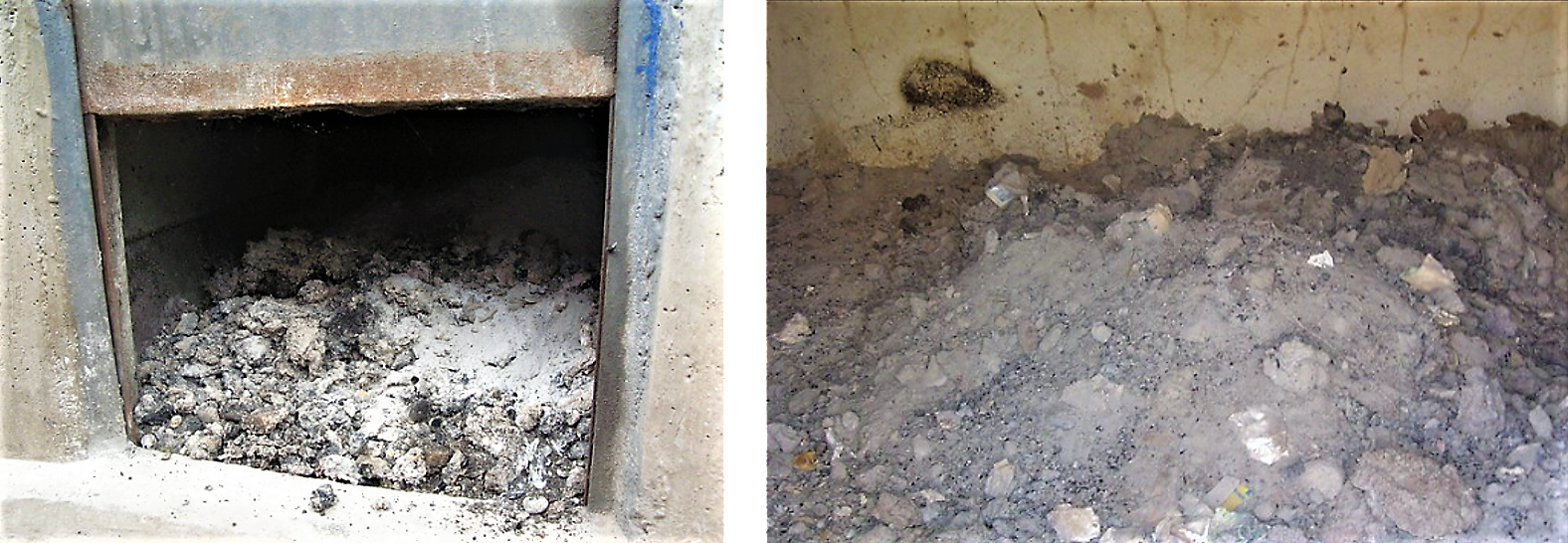
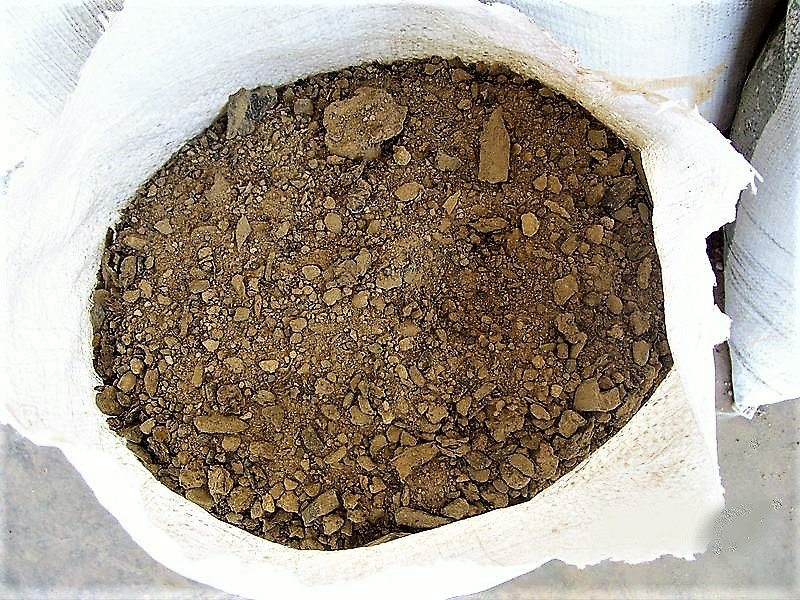
There are several options for secondary treatment: further storage, high-temperature composting, anaerobic digestion, alkaline treatment (raise of pH by adding alkaline material such as lime, ash or urea) or incineration. The thermophilic treatments (composting, digestion, incineration) for sanitation rely on all material reaching a sufficiently high temperature for a sufficiently long time to ensure pathogen die-off. This time ranges from seconds for incineration to days or even a few weeks for thermophilic composting. To achieve similar sanitation levels with dehydration and storage only, more time is required and the die-off depends not only on temperature but also on a number of other parameters, such as humidity (ventilation), pH, competition with other microorganism for nutrients etc. (WINBLAD 2004; ESF 2009).
A common practice for the treatment of faeces form urine-diversion toilets is to either dehydrate and store the faeces for a very long time, or to first store them before composting them in order to achieve pathogen die-off and prepare them for reuse (see also co-composting at small or large scale, terra preta treatment or terra preta toilets). If urine-diversion were not wanted, the alternative would be to install composting toilets (e.g. composting toilet, arborloo, fossa alterna).
Primary treatment can be achieved on-site. In UDDTs the process takes place in the dehydration vaults beneth the toilet slab and seat (see schematic above.
In dehydration toilets, the faeces are dried with the help of heat, ventilation and the addition of dry and alkaline material. Further dehydration and volume reduction is achieved by diverting urine (and anal cleansing water, if applicable) away from faeces to a separate collection chamber (WINBALD 2004). This also makes it possible to use the urine as a fertiliser (after urine storage and hygienisation or further processing such as struvite precipitation)
Dehydration vaults can be constructed indoors or with a separate superstructure. A vent pipe is required to remove humidity from the vaults and control flies and odours. The chambers should be airtight for proper functioning of the ventilation. They should be made of sealed brickwork or concrete to ensure that surface runoff cannot enter.
The main design parameters influencing the treatment performance are briefly described below.
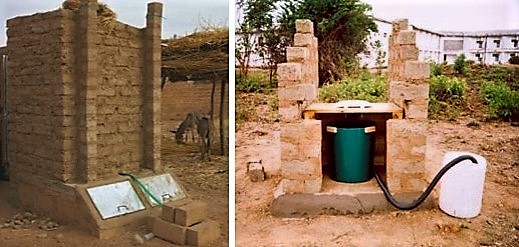
Temperature
The temperature in the dehydration vault mainly depends on the ambient temperature. At higher temperature, the faeces are dried faster and if very high temperatures can be achieved over a long period, this also kills pathogens (similar to pasteurisation). High temperature in the dehydration vaults can be achieved by exposing the vaults to the sun or by using special design. The Tecpan model of the UDDT, mainly used in Africa, provides such an option. Metal sheets are used as vault chamber doors, which are exposed to the sun in a 45° angle, in order to absorb the heat, transfer it into the vaults and speeding up the drying process. However, the inclination of the doors make them more complicated to construct and rain can enter more easily into the chambers.
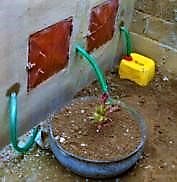
Ventilation
If single-vault UDDTs with movable containers are used, the dehydrated faeces can be directly collect in rice bags or other air-permeable low-cost material and then directly exposed to the sun away from the toilet protected from the rain. If correctly piled up (e.g. provide a grid on the floor to allow air circulation) this can also enhance ventilation.
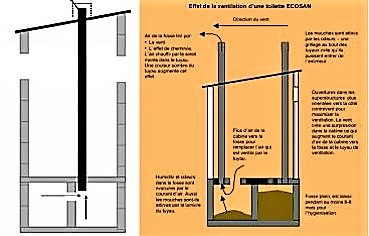
Ventilation is the process by which fresh air is introduced and ventilated air is removed from an occupied space (OKETCH 2005). Ventilation can be natural or mechanical. Mechanical ventilation requires a fan or another mechanical device and power. If correctly designed, dehydration toilets can also be sufficiently aerated naturally. For natural ventilation, a difference of pressure (or temperature) is required inside and outside. This can be given by wind or a stack effect. The stack effect can be described as follows: as warm air is lighter than cool air, it generally rises up being replaced by cooler air. In UDDTs for instance, the solar radiation heats the vent pipe outside the chamber (the pipe can bepainted in black to enhance radiation absorption). When the air in the pipe heats up, it rises upwards out of the vent; a downward draught of cooler air then flows in through the squat plate hole, replacing the vacuum space created after warm air rising (OKETCH 2005). This creates a continuous airflow from inside towards outside of the toilet housing. The rate of ventilation is directly proportional to the size of openings and the height difference between inlet and outlet of the vent pipe.
Addition of Dry and Alkaline Material
The immediate coverage of the fresh faeces with an additive material can considerable lower nuisances caused by odour or flies. The faster drying means also that the biological degradation is small if sufficient additive is used and thus, the losses of organic matter and N from the faeces to the air are small (JOENSSON et al. 2004). Ash and lime has the additional beneficial effect of raising pH, which leads to improved pathogen die-off (JOENSSON et al. 2004). The addition of ash and lime should therefore be preferred (SCHOENNING & STENSTROEM 2004). The addition of lime, ash or urea can also be used for a secondary alkaline treatment. Dehydrated faeces, which have been treated in such a way, will have an elevated pH (> 8). This may be beneficial for many soils when it is applied as compost, but it may affect crop production in already alkaline soils adversely (WHO 2006).
Another option to enhance pH is to add urea. This kind of alkaline treatment has been considered for large-scale treatment of faeces on municipal level (SCHOENNING & STENSTROEM 2004). Besides enhancing the pH urea also adds fertiliser value and further inactivates pathogens by the combination of high ammonia concentrations and pH (SCHOENNING & STENSTROEM 2004).
Time
The WHO recommends a minimum storage time of 6 months if ash or lime are used as cover material (alkaline treatment), otherwise the storage should be for at least 1 year for warm climates (>20 °C average) and for 1.5 to 2 years for colder climates.
In case of alkaline treatment, each vault is sized to accommodate at least 6 months of faeces accumulation. This results in a 6 month storage and dehydration time in the out-of-service vault. The vault dimensions should account for cover material, airflow, the non-even distribution of faeces, and possibly visitors and dry cleansing materials. It can be assumed that one person will require around 50 L of storage volume every 6 months. A minimum chamber height of 60 to 80 cm is recommended for easy emptying and access to the urine pipes.
Treatment performance
The pathogen reduction increases with increasing ambient temperature and pH. Several studies report the pathogen die-off rate in dehydrating toilet (see table 5.2 in WHO 2006).
In small-scale systems (household level), the faeces can be used after primary treatment if they have been stored for at least 1.5 to 2 years at ambient temperature of 2 to 20 °C or 1 year at temperature of 20 to 35 °C. In the case of an alkaline treatment, pH should be above 9 for at least 6 months (see table below, SCHOENNING & STENSTROEM 2004).
|
| Treatment | Criteria | Comment |
| Suggested alternative recommendations for primary (and secondary) treatment of dry faeces before use at the household level. No addition of new material. (SCHOENNING & STENSTROEM 2004) | Storage (only treatment); Ambient temperature 2-20°C | 1.5–2 years | Will eliminate most bacterial pathogens; regrowth of E. coli and Salmonella not considered if re-wetted; will substantially reduce viruses, protozoa and parasites. Some soil-borne ova may persist |
| Storage (only treatment) Ambient temperature 20-35°C | >1 YEAR | As above | |
| Alkaline treatment | pH >9 during >6 months | If temperature > 35°C and moisture < 25 %, lower pH and/or wetter material will prolong the time for absolute elimination | |
| Alternative secondary treatments suggested for faeces from large-scale systems (municipal level). No addition of new material. (SCHOENNING & STENSTROEM 2004) | Alkaline treatment | pH >9 during >6 months | Hypothesis: If temperature > 35°C or moisture < 25 %. Lower pH and/or wetter material will prolong the time for absolute elimination. |
| Temperature >50°C for >1 week | Minimum requirement. Longer time needed if temperature requirement can not be ensured | ||
| Fully incinerated (<10% carbon in ash) |
| ||
| Storage |
| Time modification needed based on local conditions. Large systems need a higher level of protection than at household level. Additional storage adds to safety |
Suggested requirement for the treatment of dehydrated faeces. Source: SCHOENNING & STENSTROEM (2004)
Larger systems (at municipal level with transport infrastructure and centralised treatment) require alkaline treatment, composting or incineration.
Shorter storage times can be applied for all systems in very dry climates, where moisture levels less than 20 % are achieved (SCHOENNING & STENSTROEM 2004).
If the moisture level is kept low (< 20 %, JOENSSON et al. 2004), the degradation is low and so are the losses of N and organics. Furthermore, since the final product is incorporated in moist soils with planted corps, the risk of ammonia or leachate losses is virtually eliminated (JOENSSON et al. 2004).
Dehydration vaults can be a clean, comfortable, and easy-to-use technology. It is crucial, however, that the users are well trained to understand how the technology works and appreciate its benefits.
When the vaults are kept dry, there should not be any problems with flies or odours. After the recommended storage time, the faeces should be very dry and relatively safe to handle, provided that they did not get wet. However, a low health risk remains. Single dehydration vaults or bins do not allow faeces to sufficiently dehydrate. When the full container needs emptying, the faeces on top are still fresh. Hence, the risk associated with the handling of faecal matter is inherently higher in single vaults compared to double vault designs. The use of alternating chambers is, therefore, recommended. However, research and field tests of sealed faeces containers (or cartridges) for safe transportation and easy cleaning, along with the corresponding logistics, are on-going.
There are many different designs of dehydration systems, which can be separated into two categories, single- and double-vault UDDTs. Double-vault models require slightly more space and are slightly more expensive than conventional latrines. However, the removal of dried faeces is not frequent and can be done safely by the user him-self. Single-vault UDDTs can be constructed with little investments needs, but a movable container should be available and space for off-site drying. But for both UDDT options, very little surface area is needed compared to the treatment of sewage or faecal sludge and no energy at all is required.
Operation and maintenance or UDDTs includes regular control of the moisture content, addition of alkaline material (lime, ash etc.) the emptying of the vault approximately every 6 month and the emptying of the urine collection container. Further addition of absorbent material may be needed when diarrhoea is prevalent.
Just like the faeces, which are dried, but not degraded in the vaults, dry cleansing materials will not decompose in the chambers. Whenever the material is intended to be applied onto fields without further treatment, it is recommended to separately collect and dispose of the dry cleansing materials. The materials can be incinerated. Toilet paper can be thrown in the faecal compartment if the material is to be composted or incinerated.
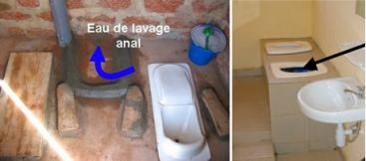
If anal cleansing is practised, a separate collection basin needs to be installed for anal cleansing. The diverted anal cleansing water can be infiltrated on-site (directly outside or beside the dehydration toilets) in a mulch or soak pit for treatment (or used for direct fertigation of trees or uneatable plants). Vegetable materials used as cleaning material can be put in the faecal compartment.
Occasionally, the faeces that have accumulated beneath the toilet should be pushed to the sides of the chamber.
Care should be taken to ensure that no water or urine gets into the dehydration vault. If this happens, extra ash, lime, soil or sawdust can be added to help absorb the liquid.
To empty the vaults, a shovel, gloves and possibly a facemask (cloth) should be used to avoid contact with the dried faeces. Faeces should be worked into the soil as soon as possible and not be left on the soil surface (they should be incorporated into the soil). Faeces should not be used for vegetables, fruits or root crops that will be consumed raw, excluding fruit trees. After the last application of dehydrated faeces for fertilisation, a withholding period of one month should additionally be applied before harvest.
| Working Principle | Drying and storage of faeces can be used as a primary and secondary treatment of faeces from dehydration toilets. Pathogens are removed by a combination of dehydration and enhancement of temperature and pH (by adding alkaline material). |
| Capacity/Adequacy | Can be done at household or community level (although community level compulsorily requires alkaline treatment). The process itself can be done in every rain protected and well-ventilated vault, bed or even in old rice bags. However, diversion toilets are required for the dry collection of faeces, as dehydration without urine-diversion functions only in very dry climates. |
| Performance | Depending on the ambient conditions and enhancement of temperature and pH, the process can last form several months to several years. |
| Costs | Moderate investment costs (depending on type of diversion toilet) and low operation costs. |
| Self-help Compatibility | Does not require any technical appliance and can be carried out everywhere. |
| O&M | Operation includes the control of the moisture content, addition of alkaline material (lime, ash etc.) and the emptying of the vault when required. Operation is easy, but the user must be well instructed to guarantee safe handling. |
| Reliability | If correctly operated (respect of required storage time periods, addition of alkaline material, control of moisture), very effective. |
| Main strength | Humanure, containing tons of nutrients and organic matter is produced and can be used to boost local agriculture. |
| Main weakness | Poor maintenance can quickly lead to malfunctioning. |
Dehydration vaults can be installed in almost every setting, from rural to dense urban areas, because of the small land area required, minimal odours and ease of use. The systems are most useful in rural and peri-urban areas, where the produced compost can be used onsite (NWP 2006).
If used in an urban context, this technology relies on a transport service for the dried faeces (and urine) since urban users normally do not have an interest and/or opportunity to use it locally. At community level alkaline treatment is compulsory. Dehydration vaults are especially appropriate for water-scarce , high temperature and rocky areas or where the groundwater table is high. They are also suitable in areas that are frequently flooded because they are built to be watertight.
The dehydration process its self can even be carried out in old rice bags or other ventilated recepients if space does not allow the construction of double-vaults. However, diversion toilets are required for the dry collection of faeces, as dehydration without urine-diversion functions only in very dry climates.
User commitment to operate and maintain the diversion and dehydration system is essential and there should be a demand for fertilising products from human faeces.
Urine Diverting Toilets Principles, Operation and Construction
All about dry urine diversion toilets, from the principles, design, construction and operation
DEGENER, S. SAMWEL, M. GABIZON, S. (2006): Urine Diverting Toilets Principles, Operation and Construction. Utrecht/Munich: Women in Europe for a Common Future (WECF) URL [Visita: 01.06.2019]Guidelines on the Use of Urine and Faeces in Crop Production
These guidelines provide a thorough background on the use of urine (and faeces) for agricultural purposes. Aspects discussed are requirements for plant growth, nutrients in excreta, hygiene aspects, and recommendations for cultivation. It provides detailed guidance on the use of urine for purposes.
JOENSSON, H. RICHERT, A. VINNERAAS, B. SALOMON, E. (2004): Guidelines on the Use of Urine and Faeces in Crop Production. (= EcoSanRes Publications Series , 2004 ). Stockholm: EcoSanRes URL [Visita: 17.04.2012]Smart Sanitation Solutions
Smart Sanitation Solutions presents examples of low-cost household and community-based sanitation solutions that have proven effective and affordable. A wide range of innovative technologies for toilets, collection, transportation, treatment and use of sanitation products that have already helped thousands of poor families to improve their lives is illustrated.
NWP (2006): Smart Sanitation Solutions. Examples of innovative, low-cost technologies for toilets, collection, transportation, treatment and use of sanitation products. (= Smart water solutions ). Amsterdam: Netherlands Water Partnership (NWP) URL [Visita: 09.05.2019]Systems for Enhancing Ventilation for Improved Control of Odour and Fly Nuisance in Dry Urine Diverting Ecological Sanitation Toilets
This research report described information for improved ventilation, fly and odour control as well as impact of improved ventilation on drying within faecal chambers and pathogen die-off in dehydration toilets.
OKETCH, M. (2005): Systems for Enhancing Ventilation for Improved Control of Odour and Fly Nuisance in Dry Urine Diverting Ecological Sanitation Toilets. URL [Visita: 22.07.2010]Technology Review of Urine-Diverting Dry Toilets (UDDTs)
This publication offers a complete overview of UDDT functions, design considerations, common operation and maintenance issues and generalised installation costs. Its focus is on applications in developing countries and countries in transition, although UDDTs are also applicable in developed countries.
RIECK, C. MUENCH, E. HOFFMANN, H. (2012): Technology Review of Urine-Diverting Dry Toilets (UDDTs). Overview on Design, Management, Maintenance and Costs. (= Technology Review ). Eschborn: German Agency for Technical Cooperation (GTZ) GmbH URL [Visita: 11.05.2019]Guidelines on the Safe Use of Urine and Faeces in Ecological Sanitation Systems
These guidelines provide a thorough background on the safe use of urine and faeces for agricultural purposes. Aspects like the health risk associated we the use of human excreta in agriculture and how to limit them are discussed.
SCHOENNING, C. STENSTROEM, T.A. (2004): Guidelines on the Safe Use of Urine and Faeces in Ecological Sanitation Systems. (= EcoSanRes Publication Series ). Stockholm: Stockholm Environment Institute (SEI)Compendium of Sanitation Systems and Technologies. 2nd Revised Edition
This compendium gives a systematic overview on different sanitation systems and technologies and describes a wide range of available low-cost sanitation technologies.
TILLEY, E. ULRICH, L. LUETHI, C. REYMOND, P. ZURBRUEGG, C. (2014): Compendium of Sanitation Systems and Technologies. 2nd Revised Edition. Duebendorf, Switzerland: Swiss Federal Institute of Aquatic Science and Technology (Eawag) URL [Visita: 28.07.2014] PDFEcological Sanitation - revised and enlarged edition
This book is one of the most fundamental and important books that defined the concept of ecological sanitation. The first version came out in 1998 - this version presents the findings of over ten years of research and development in ecological sanitation supported by SIDA (Swedish International Development Cooperation Agency).
WINBLAD, U. SIMPSON-HERBERT, M. (2004): Ecological Sanitation - revised and enlarged edition. (pdf presentation). Sweden: Stockholm Environment Institute URL [Visita: 04.08.2010]Guidelines for the safe use of wastewater excreta and greywater. Volume IV. Excreta and Greywater Use in Agriculture
Volume IV of the Guidelines for the Safe Use of Wastewater, Excreta and Greywater recognizes the reuse potential of wastewater and excreta (including urine) in agriculture and describes the present state of knowledge as regards potential health risks associated with the reuse as well as measures to manage these health risks following a multi-barrier approach.
WHO (2006): Guidelines for the safe use of wastewater excreta and greywater. Volume IV. Excreta and Greywater Use in Agriculture. Geneva: World Health Organisation (WHO) URL [Visita: 09.05.2019] PDFEcological Sanitation - revised and enlarged edition
This book is one of the most fundamental and important books that defined the concept of ecological sanitation. The first version came out in 1998 - this version presents the findings of over ten years of research and development in ecological sanitation supported by SIDA (Swedish International Development Cooperation Agency).
WINBLAD, U. SIMPSON-HERBERT, M. (2004): Ecological Sanitation - revised and enlarged edition. (pdf presentation). Sweden: Stockholm Environment Institute URL [Visita: 04.08.2010]Compendium of Sanitation Systems and Technologies (Arabic)
This is the Arabic version of the Compendium of Sanitation Systems and Technologies. The Compendium gives a systematic overview on different sanitation systems and technologies and describes a wide range of available low-cost sanitation technologies.
TILLEY, E. ULRICH, L. LUETHI, C. REYMOND, P. SCHERTENLEIB, R. ZURBRUEGG, C. (2014): Compendium of Sanitation Systems and Technologies (Arabic). 2nd Revised Edition. Duebendorf, Switzerland: Swiss Federal Institute of Aquatic Science and Technology (Eawag) PDFUrine Diverting Dry Toilets
This manual provides the background of ecological sanitation and gives guidance how to construct and operate a UDDT. The manual, originally published in 2006, has been revised based on the experiences of more than 10 years in 12 countries by WECF with local partners.
DEEGENER, S. SAMWEL, M. WENDLAND, C. (2015): Urine Diverting Dry Toilets. Principles, Operation and Construction. Women in Europe for a Common Future (WECF) URL [Visita: 29.11.2015]Ecological Sanitation
This book puts forward ecological sanitation as an alternative to conventional sanitation, and was one of the very first of its kind. It documents different options of ecosan based on dehydrating and composting toilets in use around the world. The book has been reviewed and enlarged since then.
ESREY, S. A. ; GOUGH, J. ; RAPAPORT, D. ; SAWYER, R. ; MAYLING, S.H. ; VARGAS, J. ; WINBLAD, U. (1998): Ecological Sanitation. Stockholm: Swedish International Development Cooperation Agency (SIDA) URL [Visita: 31.05.2019]Guidelines on the Use of Urine and Faeces in Crop Production
These guidelines provide a thorough background on the use of urine (and faeces) for agricultural purposes. Aspects discussed are requirements for plant growth, nutrients in excreta, hygiene aspects, and recommendations for cultivation. It provides detailed guidance on the use of urine for purposes.
JOENSSON, H. RICHERT, A. VINNERAAS, B. SALOMON, E. (2004): Guidelines on the Use of Urine and Faeces in Crop Production. (= EcoSanRes Publications Series , 2004 ). Stockholm: EcoSanRes URL [Visita: 17.04.2012]How to Select Appropriate Technical Solutions for Sanitation
The purpose of this guide is to assist local contracting authorities and their partners in identifying those sanitation technologies best suited to the different contexts that exist within their town. The first part of the guide contains a planning process and a set of criteria to be completed; these assist you in characterizing each area of intervention so that you are then in a position to identify the most appropriate technical solutions. The second part of the guide consists of technical factsheets which give a practical overview of the technical and economic characteristics, the operating principle and the pros and cons of the 29 sanitation technology options most commonly used in sub-Saharan Africa.
MONVOIS, J. GABERT, J. FRENOUX, C. GUILLAUME, M. (2010): How to Select Appropriate Technical Solutions for Sanitation. (= Six Methodological Guides for a Water and Sanitation Services' Development Strategy , 4 ). Cotonou and Paris: Partenariat pour le Développement Municipal (PDM) and Programme Solidarité Eau (pS-Eau) URL [Visita: 19.10.2011]Systems for Enhancing Ventilation for Improved Control of Odour and Fly Nuisance in Dry Urine Diverting Ecological Sanitation Toilets
This research report described information for improved ventilation, fly and odour control as well as impact of improved ventilation on drying within faecal chambers and pathogen die-off in dehydration toilets.
OKETCH, M. (2005): Systems for Enhancing Ventilation for Improved Control of Odour and Fly Nuisance in Dry Urine Diverting Ecological Sanitation Toilets. URL [Visita: 22.07.2010]Health and Safety Aspects of the Use of Products from Urine Diversion Toilets
This research report describes the inactivation of pathogens in human faeces from dehydration toilets under different moisture, temperature and pH conditions.
PASHA-MMOLAWA, C. (2006): Health and Safety Aspects of the Use of Products from Urine Diversion Toilets. Pretoria: University of Pretoria URL [Visita: 22.07.2010]Technology Review of Urine-Diverting Dry Toilets (UDDTs)
This publication offers a complete overview of UDDT functions, design considerations, common operation and maintenance issues and generalised installation costs. Its focus is on applications in developing countries and countries in transition, although UDDTs are also applicable in developed countries.
RIECK, C. MUENCH, E. HOFFMANN, H. (2012): Technology Review of Urine-Diverting Dry Toilets (UDDTs). Overview on Design, Management, Maintenance and Costs. (= Technology Review ). Eschborn: German Agency for Technical Cooperation (GTZ) GmbH URL [Visita: 11.05.2019]Guidelines on the Safe Use of Urine and Faeces in Ecological Sanitation Systems
These guidelines provide a thorough background on the safe use of urine and faeces for agricultural purposes. Aspects like the health risk associated we the use of human excreta in agriculture and how to limit them are discussed.
SCHOENNING, C. STENSTROEM, T.A. (2004): Guidelines on the Safe Use of Urine and Faeces in Ecological Sanitation Systems. (= EcoSanRes Publication Series ). Stockholm: Stockholm Environment Institute (SEI)Compendium of Sanitation Systems and Technologies. 2nd Revised Edition
This compendium gives a systematic overview on different sanitation systems and technologies and describes a wide range of available low-cost sanitation technologies.
TILLEY, E. ULRICH, L. LUETHI, C. REYMOND, P. ZURBRUEGG, C. (2014): Compendium of Sanitation Systems and Technologies. 2nd Revised Edition. Duebendorf, Switzerland: Swiss Federal Institute of Aquatic Science and Technology (Eawag) URL [Visita: 28.07.2014] PDFGuidelines for the safe use of wastewater excreta and greywater. Volume IV. Excreta and Greywater Use in Agriculture
Volume IV of the Guidelines for the Safe Use of Wastewater, Excreta and Greywater recognizes the reuse potential of wastewater and excreta (including urine) in agriculture and describes the present state of knowledge as regards potential health risks associated with the reuse as well as measures to manage these health risks following a multi-barrier approach.
WHO (2006): Guidelines for the safe use of wastewater excreta and greywater. Volume IV. Excreta and Greywater Use in Agriculture. Geneva: World Health Organisation (WHO) URL [Visita: 09.05.2019] PDFEcological Sanitation - revised and enlarged edition
This book is one of the most fundamental and important books that defined the concept of ecological sanitation. The first version came out in 1998 - this version presents the findings of over ten years of research and development in ecological sanitation supported by SIDA (Swedish International Development Cooperation Agency).
WINBLAD, U. SIMPSON-HERBERT, M. (2004): Ecological Sanitation - revised and enlarged edition. (pdf presentation). Sweden: Stockholm Environment Institute URL [Visita: 04.08.2010]The Characterization of Feces and Urine: A Review of the Literature to Inform Advanced Treatment Technology
Development of on-site sanitation facilities that treat excreta require knowledge of the waste stream entering the system. This paper contains data regarding the generation rate and the chemical and physical composition of fresh feces and urine. In addition, the impact on biological and thermal processes, physical separators, and chemical reactions is also assessed.
ROSE, C. ; PARKER, A. ; JEFFERSON, B. ; CARTMELL, E. (2015): The Characterization of Feces and Urine: A Review of the Literature to Inform Advanced Treatment Technology. Entradas: Critical Reviews in Environmental Science and Technology: Volume 45 , 1827-1879. URL [Visita: 25.11.2015]UDD Toilets in Rural School Hayanist, Armenia
This case study reports the establishment of a sustainable, affordable and safe school sanitation system in a rural area in Armenia. A total number of 7 Double-Vault UDDTs serve ca. 350 students (females and males) and 26 staff members. Urine is stored for 6 months before application.
DEEGENER, S. SAMWEL, M. ANAKHASYAN, E. (2009): UDD Toilets in Rural School Hayanist, Armenia. (= SuSanA - Case Studies ). Eschborn: Sustainable Sanitation Alliance (SuSanA) URL [Visita: 07.07.2010]Urban Urine Diversion Dehydration Toilets and Reuse Ouagadougou Burkina Faso - Draft
This case studies reports form the implementation of ecosan toilets in the peri-urban area of Ouagadougou financed by the European Union. The aim of the project was to demonstrate ecosan on an urban level with a centralised collection and treatment facilities and commercialisation of hygienised urine and faeces.
FALL, A. (2009): Urban Urine Diversion Dehydration Toilets and Reuse Ouagadougou Burkina Faso - Draft. (= SuSanA - Case Studies ). Eschborn: Sustainable Sanitation Alliance (SuSanA) URL [Visita: 31.05.2019]Urine Diversion Dry Toilet (UDDT) for Agafari´s Household, Arba Minch, Ethiopia
This case study reports the replacement of pit latrine with UDDT at one household in Arba Minch, Ethiopia. A single-vault UDDT serves family members and rural merchants staying overnight. Urine is applied for banana, mango and lemon plants and the dried excreta are co-composted along with organic material in the owner’s farmland.
KASSA, K. (2010): Urine Diversion Dry Toilet (UDDT) for Agafari´s Household, Arba Minch, Ethiopia. (= SuSanA - Case Studies ). Eschborn: Sustainable Sanitation Alliance (SuSanA) URL [Visita: 12.12.2012]Urine-Diversion Dehydration Toilets in Rural Areas, Bayawan City, Philippines
In Bayawan City (Philippines), UDDTs were installed on household and public level. Vegetable growers and small-scale farmers use the fertilising products.
LIPKOW, U. (2009): Urine-Diversion Dehydration Toilets in Rural Areas, Bayawan City, Philippines. (= SuSanA - Case Studies ). Eschborn: Sustainable Sanitation Alliance (SuSanA) URL [Visita: 07.07.2010]Assessment of Urine Diverting Ecosan Toilets in Nepal
This study assesses ecosan toilets and their implementation in different areas of Nepal from an n social, technical and financial point of view. It gives recommendations in the view of scaling-up ecosan in Nepal.
WATERAID (2008): Assessment of Urine Diverting Ecosan Toilets in Nepal. Kathmandu: WaterAid Nepal URL [Visita: 31.05.2019]Ecological Sanitation in Malawi
This illustrative presentation on ecological sanitation in Malawi, focuses on the concept of ecological sanitation, types of eco-toilets and basic methods of recycling nutrient from human excreta.
MORGAN, P. (2010): Ecological Sanitation in Malawi. Stockholm : Ecological Sanitation Research (EcoSanRes), Stockholm Environment Institute (SEI) URL [Visita: 31.05.2019]Urine Diverting Dry Toilets
This manual provides the background of ecological sanitation and gives guidance how to construct and operate a UDDT. The manual, originally published in 2006, has been revised based on the experiences of more than 10 years in 12 countries by WECF with local partners.
DEEGENER, S. SAMWEL, M. WENDLAND, C. (2015): Urine Diverting Dry Toilets. Principles, Operation and Construction. Women in Europe for a Common Future (WECF) URL [Visita: 29.11.2015]Guidelines on the Safe Use of Urine and Faeces in Crop Production. Factsheet N0. 6
This factsheet is a short version of the guidelines for the safe use of urine and faeces for agricultural purposes providing information about requirements for plant growth, nutrients in excreta, hygiene aspects, and recommendations and guidance for cultivation.
ECOSANRES (2008): Guidelines on the Safe Use of Urine and Faeces in Crop Production. Factsheet N0. 6. Harare (Zimbabwe): Stockholm Environment Institute EcoSanRes Programme URL [Visita: 20.07.2010]Guidelines on the Safe Use of Urine and Faeces in Ecological Sanitation Systems
These guidelines provide a thorough background on the safe use of urine and faeces for agricultural purposes. Aspects like the health risk associated we the use of human excreta in agriculture and how to limit them are discussed.
SCHOENNING, C. STENSTROEM, T.A. (2004): Guidelines on the Safe Use of Urine and Faeces in Ecological Sanitation Systems. (= EcoSanRes Publication Series ). Stockholm: Stockholm Environment Institute (SEI)Urine Diversion Dehydration Toilet (UDDT) - Construction Manual
Design and construction manual on that also provides information on the nutrient value of human urine and faecal matter, general hygiene aspects, the reuse of sanitized urine and faecal matter, and costs of various Indian UDDT designs.
ESF (2009): Urine Diversion Dehydration Toilet (UDDT) - Construction Manual. Pune: Ecosan Services Foundation (ESF) URL [Visita: 07.07.2010]Dehydration Toilets. Dehydration Toilet with movable containers
Short general and technical description on single-vault UDDTs with movable containers.
GTZ (2006): Dehydration Toilets. Dehydration Toilet with movable containers . (= Technical Data Sheets for Ecosan Components, 02-B4 ). Eschborn: German Agency for Technical Cooperation (GTZ) GmbH URL [Visita: 31.05.2019]Dehydration Toilets. Dehydration toilets Construction Plans – selected examples
Description of some examples of construction plans for dehydration toilets.
GTZ (2006): Dehydration Toilets. Dehydration toilets Construction Plans – selected examples. (= Technical Data Sheets for Ecosan Components, 02-C1 ). Eschborn: German Agency for Technical Cooperation (GTZ) GmbH URL [Visita: 31.05.2019]Dehydration Toilets. Dehydration toilets. Dehydration Toilets without Urine-diversion
Short general and technical description on dehydration toilets without urine diversion.
GTZ (2006): Dehydration Toilets. Dehydration toilets. Dehydration Toilets without Urine-diversion. (= Technical Data Sheets for Ecosan Components, 02-B3 ). Eschborn: German Agency for Technical Cooperation (GTZ) GmbH URL [Visita: 31.05.2019]Dehydration Toilets. Double-vault Dehydration Toilets with Urine-diversion
Short general and technical description on double-vault UDDTs.
GTZ (2006): Dehydration Toilets. Double-vault Dehydration Toilets with Urine-diversion . (= Technical Data Sheets for Ecosan Components, 02-B1 ). Eschborn: German Agency for Technical Cooperation (GTZ) GmbH URL [Visita: 31.05.2019]Dehydration Toilets. General Description
Short general description on dehydration toilets.
GTZ (2006): Dehydration Toilets. General Description . (= Technical Data Sheets for Ecosan Components, 02-A ). Eschborn: German Agency for Technical Cooperation (GTZ) GmbH URL [Visita: 31.05.2019]Dehydration Toilets. Single-vault Dehydration Toilets with Urine-diversion
Short general and technical description on single-vault UDDTs.
GTZ (2006): Dehydration Toilets. Single-vault Dehydration Toilets with Urine-diversion . (= Technical Data Sheets for Ecosan Components, 02-B2 ). Eschborn: German Agency for Technical Cooperation (GTZ) GmbH URL [Visita: 31.05.2019]Dehydration Toilets. User Instructions for Dehydration Toilets
Selected examples of graphical user instruction for dehydration toilets.
GTZ (2006): Dehydration Toilets. User Instructions for Dehydration Toilets . (= Technical Data Sheets for Ecosan Components, 02-C2 ). Eschborn: German Agency for Technical Cooperation (GTZ) GmbH URL [Visita: 31.05.2019]Technology Review of Urine-Diverting Dry Toilets (UDDTs)
This publication offers a complete overview of UDDT functions, design considerations, common operation and maintenance issues and generalised installation costs. Its focus is on applications in developing countries and countries in transition, although UDDTs are also applicable in developed countries.
RIECK, C. MUENCH, E. HOFFMANN, H. (2012): Technology Review of Urine-Diverting Dry Toilets (UDDTs). Overview on Design, Management, Maintenance and Costs. (= Technology Review ). Eschborn: German Agency for Technical Cooperation (GTZ) GmbH URL [Visita: 11.05.2019]Smart Sanitation Solutions
Smart Sanitation Solutions presents examples of low-cost household and community-based sanitation solutions that have proven effective and affordable. A wide range of innovative technologies for toilets, collection, transportation, treatment and use of sanitation products that have already helped thousands of poor families to improve their lives is illustrated.
NWP (2006): Smart Sanitation Solutions. Examples of innovative, low-cost technologies for toilets, collection, transportation, treatment and use of sanitation products. (= Smart water solutions ). Amsterdam: Netherlands Water Partnership (NWP) URL [Visita: 09.05.2019]Food security and productive sanitation systems
The factsheet describes the food security situation especially in light of limited global resources, the role of sustainable sanitation in closing the nutrient loop and increasing productivity, and challenges in implementing productive sanitation systems.
SUSANA (2009): Food security and productive sanitation systems. (= SuSanA fact sheet 05/2009 ). Eschborn: Sustainable Sanitation Alliance (SuSanA) URL [Visita: 07.05.2019]The Dry Composting Toilet. An efficient, dignified, and healthy system for everyone
This nicely illustrated article explains the advantages of dry composting toilets over flushing systems and how they can be beneficial to everyone.
CASTILLO-CASTILLO, L. (2003): The Dry Composting Toilet. An efficient, dignified, and healthy system for everyone. URL [Visita: 22.07.2010]The 21st Century Toilets Produce Fertilizer Instead of Waste Water
This trilingual (French, English, and Arabic) poster illustrates and explains how to properly used a urine-diversion dehydration toilet.
UNKNOWN (n.y): The 21st Century Toilets Produce Fertilizer Instead of Waste Water. URL [Visita: 07.07.2010]Sustainable Sanitation Alliance (SuSanA)
The official website of the Sustainable Sanitation Alliance SuSanA. SuSanA is a loose network of a number of organizations active in the field of sanitation, founded in 2007. The goals and objectives of SuSanA are to contribute to the achievement of the MDGs, to raise awareness on what sustainable sanitation solutions are and to promote them on a larger scale. The website contains a number of Factsheets by the different SuSanA working groups on various subjects related to sustainable sanitation. There is section where everyone can upload important documents.


